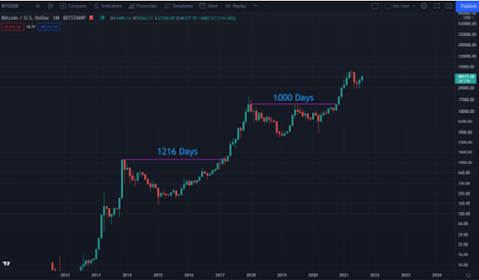So, you bought Bitcoin at around $65,000 in April and saw the value of your holding drop more than 50% in just a couple of months. Cryptocurrencies got hammered between April and July, with most of them losing value by 50% or more. Crypto investors expect volatility and are often prepared for it. Short-term volatility is bearable, but how would you behave in a prolonged bear market? And what options do you have?
A Bumpy Ride
Bulls and bears have replaced each other unpredictably and frequently. Bitcoin hit an all-time high of $64,863.1 in April, then plunged to around $30,000 in June. People who bought at the top would have lost 54% of their investment in just a couple of months, at least on paper. The steep downturn came at a time when crypto bulls were predicting $100,000 Bitcoin price.
Cryptocurrencies have shown signs of strength in recent weeks, with Bitcoin now hovering around $49,000. But nothing is certain in a nascent but promising asset class like crypto. Bitcoin might not hit the all-time high of $65,000 again for months or years.

Regulations are the single biggest risk to cryptocurrencies. Even the steep drawdown over the last few months was triggered by China’s crackdown on bitcoin mining. Notably, Beijing has cracked down on mining, but it hasn’t banned cryptocurrencies or blockchain technology. A global regulatory crackdown could keep the crypto market depressed for a long time.
Exploring Your Options
If you bought crypto assets during a boom, you certainly have seen the prices dip into the scary-zone at least once. It gets exceptionally difficult to make rational decisions during the bear phase when the bombardment of negative news makes it feel like the world is falling apart.
Panic selling is one of the worst things you can do when the market is down. Unless a coin is facing an existential threat or you want to take advantage of tax loss harvesting, it makes little sense to sell them at the bottom. Investors need to develop various strategies that allow them to survive the bear market because the objective is to either make some profit or avoid losing money even in unfriendly conditions.
Earn Passive Income on Your Crypto
While you hold for the long-term waiting for price appreciation, you could earn passive income on your crypto assets by staking them in a staking pool. It reduces the opportunity cost of holding the tokens or NFTs.
Money flows into your account while you literally do nothing, except of course, contributing to improve the network security. YeFi.one is a staking dApp where crypto HODLers can stake their tokens to earn a very high annual percentage yield (APY) on their idle tokens.
Users can withdraw their interest anytime from YeFi.one. Besides offering a non-custodial staking system, it is a secure DeFi platform that bridges decentralized data storage projects to DeFi through high performance blockchain.
According to a report by Staked, a staggering $20 billion was paid out in staking rewards to investors in 2020. Though the rewards range from 2.5% to 300%, the Staked report found that the average staking reward was 11.2% for investors.
For the uninitiated, staking is the process of locking your tokens in a wallet to perform various network functions such as transaction validation on a Proof of Stake blockchain. Sometimes staking involves adding or delegating your tokens to a staking pool. When you are earning handsome returns by staking your tokens, you wouldn’t feel bad if the price doesn’t appreciate spectacularly in the long run.
Yield farming is another way to minimize the opportunity cost of HODLing crypto. To explain it simplistically, yield farming is similar to bank loans. People pool their crypto together into a DeFi protocol to earn interest from trading fees.
Reef Finance is a one-stop cross-chain DeFi operating system built with Polkadot Substrate to make DeFi easy-to-use for newcomers. Its Global Liquidity Aggregator, Smart Yield Farming Aggregator, and Smart Asset Management make it easy for noobs to get started with yield farming. Reef goes a step further in understanding your expectations, goals, and needs. Its AI tools allow for asset management based on each individual investor’s plans, goals, and risk appetite.
An Opportunity to Accumulate
If you are a long-term optimist, bear markets could be a golden opportunity to accumulate the coins you believe in at attractive prices. Nobody can predict where the bottom is or how long a bear is going to last. So, buying a little bit frequently throughout the bear market brings down your average buying price without worrying about the bottom.
After all, accumulating during a bear market could reap massive rewards when the tide turns. For example, Bitcoin was at just $4,000 in March 2020. A year later it was trading above $50,000! Even after a steep decline in May and June 2021, it’s trading far above the $4,000 level in March 2020.
Make sure that you are buying the right assets. Most assets become “cheap” in a bear market, but cheap doesn’t always mean value. Don’t buy something just because it looks incredibly cheap because if it falls to zero, you’ll lose 100% of your investment. Look for projects and assets with sustainable long-term potential.
Despite the volatility and regulatory risks, there are strong reasons to be long-term optimistic about cryptocurrencies. Some of the world’s leading financial institutions are loading up on crypto. Tesla, PayPal, Square, Grayscale, and others have embraced Bitcoin. Morgan Stanley has started offering Bitcoin trading. El Salvador has accepted Bitcoin as legal tender, and other countries such as Mexico, Argentina, and Brazil are also considering it.
The key to HODLing is to endure the pressure while the story plays out.
Tax Loss Harvesting
You might want to sell your crypto at a loss in the so-called “long winter” to reduce or eliminate your tax liability on winning investments. In the US, regulators treat cryptocurrencies as “property” rather than “securities.” It means the crypto losses are booked slightly differently than stocks and mutual funds. Wash sale rules don’t apply to crypto.
Crypto investors and traders can sell for tax loss harvesting, and then quickly repurchase the assets sold earlier not to miss out on the subsequent price rebound. Stock market investors aren’t allowed to buy back the same or similar securities within 30 days before or 30 days after a sale without triggering penalties. Since crypto is “property” rather than “securities,” you can buy back crypto assets immediately.
Talking about taxes, it’s important to be aware of all the tax-deductible business expenses. Platforms like CryptoTaxCalculator simplify the record-keeping and tax filing for crypto traders. Such tools come handy if you want to reduce your tax liability without incurring the wrath of the IRS.
Ponzi schemes also get exposed in a prolonged bear market. Thankfully, traders can deduct their Ponzi losses from their taxable income. In case you didn’t know, Ponzi losses are not subject to the $3,000 capital loss limitation in the United States. If you have lost crypto in scams, hacks or theft, you can claim the loss as a $0 proceeds transaction.
Conclusion
If you believe you have overpaid for a cryptocurrency that got hammered in a bear market, the most important thing you can do is not to panic but to ask yourself: Why am I HODLing it? If you have faith in the coin or project, you could double down on it in a bear market. You can earn passive income by staking or yield farming in the meantime. But if you have lost conviction or you’ve been a victim of a scam, get out but don’t forget to use it to reduce your tax bill.





